Silver Nanofunctionalized Stent after Radiofrequency Ablation Suppresses Tissue Hyperplasia and Bacterial Growth
Abstract
1. Introduction
2. Materials and Methods
2.1. Preparation and Surface Characteristics of AgNPs-Coated SEMS
2.2. Release of Ag Ions from AgNPs-Coated SEMS
2.3. Bacterial Resistance of AgNPs-Coated SEMS
2.4. RF Ablation Equipment and Electrode
2.5. Animal Study Design
2.6. Protocol for RF Ablation in the Rabbit Bile Duct
2.7. RF Ablation with Stent Placement
2.8. Cholangiographic Examination
2.9. Hematology
2.10. Gross and Histological Examination
2.11. Immunohistochemistry Analysis
2.12. Statistical Analysis
3. Results
3.1. Surface Characteristics of AgNPs-Coated SEMS
3.2. Ag Ions Release Behavior of AgNPs-Coated SEMS
3.3. In Vitro Antibacterial Efficacy of AgNPs-Coated SEMS
3.4. Protocol for RF Ablation in the Rabbit Bile Duct
3.5. Procedural Outcomes in the In Vivo Study
3.6. Cholangiographic Findings
3.7. Hematology
3.8. Gross and Histological Findings
3.9. Immunohistochemistry Findings
4. Discussion
5. Conclusions
Supplementary Materials
Author Contributions
Funding
Institutional Review Board Statement
Informed Consent Statement
Data Availability Statement
Acknowledgments
Conflicts of Interest
References
- Irisawa, A.; Katanuma, A.; Itoi, T. Otaru consensus on biliary stenting for unresectable distal malignant biliary obstruction. Dig. Endosc. 2013, 25 (Suppl. S2), 52–57. [Google Scholar] [CrossRef] [PubMed]
- Inoue, T.; Yoneda, M. Updated evidence on the clinical impact of endoscopic radiofrequency ablation in the treatment of malignant biliary obstruction. Dig. Endosc. 2022, 34, 345–358. [Google Scholar] [CrossRef] [PubMed]
- Cha, B.H.; Jang, M.J.; Lee, S.H. Survival Benefit of Intraductal Radiofrequency Ablation for Malignant Biliary Obstruction: A Systematic Review with Meta-Analysis. Clin. Endosc. 2021, 54, 100–106. [Google Scholar] [CrossRef] [PubMed]
- Zheng, X.; Bo, Z.Y.; Wan, W.; Wu, Y.C.; Wang, T.T.; Wu, J.; Gao, D.J.; Hu, B. Endoscopic radiofrequency ablation may be preferable in the management of malignant biliary obstruction: A systematic review and meta-analysis. J. Dig. Dis. 2016, 17, 716–724. [Google Scholar] [CrossRef]
- Uyanık, S.A.; Öğüşlü, U.; Yılmaz, B.; Çevik, H.; Atlı, E.; Gümüş, B. Percutaneous Intraductal Microwave Ablation of Malignant Biliary Strictures: Initial Experience. AJR Am. J. Roentgenol. 2020, 215, 753–759. [Google Scholar] [CrossRef]
- Lawrence, C.; Nieto, J.; Parsons, W.G.; Roy, A.; Guda, N.M.; Steinberg, S.E.; Hasan, M.K.; Bucobo, J.C.; Nagula, S.; Dey, N.D.; et al. A newly designed uncovered biliary stent for palliation of malignant obstruction: Results of a prospective study. BMC Gastroenterol. 2020, 20, 184. [Google Scholar] [CrossRef]
- Lu, J.; Guo, J.H.; Zhu, H.D.; Zhu, G.Y.; Wang, Y.; Zhang, Q.; Chen, L.; Wang, C.; Pan, T.F.; Teng, G.J. Palliative treatment with radiation-emitting metallic stents in unresectable Bismuth type III or IV hilar cholangiocarcinoma. ESMO Open 2017, 2, e000242. [Google Scholar] [CrossRef]
- Cho, J.H.; Jeon, T.J.; Park, J.Y.; Kim, H.M.; Kim, Y.J.; Park, S.W.; Chung, J.B.; Song, S.Y.; Bang, S. Comparison of outcomes among secondary covered metallic, uncovered metallic, and plastic biliary stents in treating occluded primary metallic stents in malignant distal biliary obstruction. Surg. Endosc. 2011, 25, 475–482. [Google Scholar] [CrossRef]
- Sofi, A.A.; Khan, M.A.; Das, A.; Sachdev, M.; Khuder, S.; Nawras, A.; Lee, W. Radiofrequency ablation combined with biliary stent placement versus stent placement alone for malignant biliary strictures: A systematic review and meta-analysis. Gastrointest. Endosc. 2018, 87, 944–951.e1. [Google Scholar] [CrossRef]
- Park, W.; Kim, K.Y.; Kang, J.M.; Ryu, D.S.; Kim, D.H.; Song, H.Y.; Kim, S.H.; Lee, S.O.; Park, J.H. Metallic Stent Mesh Coated with Silver Nanoparticles Suppresses Stent-Induced Tissue Hyperplasia and Biliary Sludge in the Rabbit Extrahepatic Bile Duct. Pharmaceutics 2020, 12, 563. [Google Scholar] [CrossRef]
- Park, J.S.; Jeong, S.; Kim, J.M.; Park, S.S.; Lee, D.H. Development of a Swine Benign Biliary Stricture Model Using Endoscopic Biliary Radiofrequency Ablation. J. Korean Med. Sci. 2016, 31, 1438–1444. [Google Scholar] [CrossRef] [PubMed]
- Hu, B.; Gao, D.J.; Wu, J.; Wang, T.T.; Yang, X.M.; Ye, X. Intraductal radiofrequency ablation for refractory benign biliary stricture: Pilot feasibility study. Dig. Endosc. 2014, 26, 581–585. [Google Scholar] [CrossRef] [PubMed]
- Jarosova, J.; Macinga, P.; Hujova, A.; Kral, J.; Urban, O.; Spicak, J.; Hucl, T. Endoscopic radiofrequency ablation for malignant biliary obstruction. World J. Gastrointest. Oncol. 2021, 13, 1383–1396. [Google Scholar] [CrossRef] [PubMed]
- Laquière, A. Safety and feasibility of endoscopic biliary radiofrequency ablation treatment of extrahepatic cholangiocarcinoma. Surg. Endosc. 2016, 30, 1242–1248. [Google Scholar] [CrossRef] [PubMed]
- Kang, H.; Chung, M.J.; Cho, I.R.; Jo, J.H.; Lee, H.S.; Park, J.Y.; Park, S.W.; Song, S.Y.; Bang, S. Efficacy and safety of palliative endobiliary radiofrequency ablation using a novel temperature-controlled catheter for malignant biliary stricture: A single-center prospective randomized phase II TRIAL. Surg. Endosc. 2021, 35, 63–73. [Google Scholar] [CrossRef]
- Rustagi, T.; Jamidar, P.A. Intraductal radiofrequency ablation for management of malignant biliary obstruction. Dig. Dis. Sci. 2014, 59, 2635–2641. [Google Scholar] [CrossRef]
- Mizandari, M.; Pai, M.; Xi, F.; Valek, V.; Tomas, A.; Quaretti, P.; Golfieri, R.; Mosconi, C.; Guokun, A.; Kyriakides, C.; et al. Percutaneous intraductal radiofrequency ablation is a safe treatment for malignant biliary obstruction: Feasibility and early results. Cardiovasc. Interv. Radiol. 2013, 36, 814–819. [Google Scholar] [CrossRef]
- Wu, T.T.; Li, W.M.; Li, H.C.; Ao, G.K.; Zheng, F.; Lin, H. Percutaneous Intraductal Radiofrequency Ablation for Extrahepatic Distal Cholangiocarcinoma: A Method for Prolonging Stent Patency and Achieving Better Functional Status and Quality of Life. Cardiovasc. Intervent. Radiol. 2017, 40, 260–269. [Google Scholar] [CrossRef]
- Cui, W.; Wang, Y.; Fan, W.; Lu, M.; Zhang, Y.; Yao, W.; Li, J. Comparison of intraluminal radiofrequency ablation and stents vs. stents alone in the management of malignant biliary obstruction. Int. J. Hyperth. 2017, 33, 853–861. [Google Scholar] [CrossRef]
- Larghi, A.; Rimbaș, M.; Tringali, A.; Boškoski, I.; Rizzatti, G.; Costamagna, G. Endoscopic radiofrequency biliary ablation treatment: A comprehensive review. Dig. Endosc. 2019, 31, 245–255. [Google Scholar] [CrossRef]
- Wang, F.; Li, Q.; Zhang, X.; Jiang, G.; Ge, X.; Yu, H.; Nie, J.; Ji, G.; Miao, L. Endoscopic radiofrequency ablation for malignant biliary strictures. Exp. Ther. Med. 2016, 11, 2484–2488. [Google Scholar] [CrossRef] [PubMed][Green Version]
- Steel, A.W.; Postgate, A.J.; Khorsandi, S.; Nicholls, J.; Jiao, L.; Vlavianos, P.; Habib, N.; Westaby, D. Endoscopically applied radiofrequency ablation appears to be safe in the treatment of malignant biliary obstruction. Gastrointest. Endosc. 2011, 73, 149–153. [Google Scholar] [CrossRef] [PubMed]
- Masood, N.; Ahmed, R.; Tariq, M.; Ahmed, Z.; Masoud, M.S.; Ali, I.; Asghar, R.; Andleeb, A.; Hasan, A. Silver nanoparticle impregnated chitosan-PEG hydrogel enhances wound healing in diabetes induced rabbits. Int. J. Pharm. 2019, 559, 23–36. [Google Scholar] [CrossRef] [PubMed]
- Bonete, J.M.; Silva, G.D.; Guidelli, E.J.; GonCalves, P.J.; Almeida, L.M.; Baffa, O.; Kinoshita, A. Tissue reaction and anti-biofilm action of new biomaterial composed of latex from Hancornia speciosa Gomes and silver nanoparticles. An. Acad. Bras. Cienc. 2020, 92, e20191584. [Google Scholar] [CrossRef]
- Cochis, A.; Azzimonti, B.; Della Valle, C.; De Giglio, E.; Bloise, N.; Visai, L.; Cometa, S.; Rimondini, L.; Chiesa, R. The effect of silver or gallium doped titanium against the multidrug resistant Acinetobacter baumannii. Biomaterials 2016, 80, 80–95. [Google Scholar] [CrossRef]
- Zhao, H.; Fu, Y.; Tsauo, J.; Zhang, X.; Zhao, Y.; Gong, T.; Li, J.; Li, X. Silver nanoparticle-coated self-expandable metallic stent suppresses tissue hyperplasia in a rat esophageal model. Surg. Endosc. 2022, 36, 66–74. [Google Scholar] [CrossRef]
- Yang, F.; Ren, Z.; Chai, Q.; Cui, G.; Jiang, L.; Chen, H.; Feng, Z.; Chen, X.; Ji, J.; Zhou, L.; et al. A novel biliary stent coated with silver nanoparticles prolongs the unobstructed period and survival via anti-bacterial activity. Sci. Rep. 2016, 6, 21714. [Google Scholar] [CrossRef]
- Lee, T.H.; Jang, B.S.; Jung, M.K.; Pack, C.G.; Choi, J.H.; Park, D.H. Fabrication of a silver particle-integrated silicone polymer-covered metal stent against sludge and biofilm formation and stent-induced tissue inflammation. Sci. Rep. 2016, 6, 35446. [Google Scholar] [CrossRef]
- Park, J.H.; Park, W.; Cho, S.; Kim, K.Y.; Tsauo, J.; Yoon, S.H.; Son, W.C.; Kim, D.H.; Song, H.Y. Nanofunctionalized Stent-Mediated Local Heat Treatment for the Suppression of Stent-Induced Tissue Hyperplasia. ACS Appl. Mater. Interfaces 2018, 10, 29357–29366. [Google Scholar] [CrossRef]
- Park, J.H.; Kim, M.T.; Kim, K.Y.; Bakheet, N.; Kim, T.H.; Jeon, J.Y.; Park, W.; Lopera, J.E.; Kim, D.H.; Song, H.Y. Local Heat Treatment for Suppressing Gastroduodenal Stent-Induced Tissue Hyperplasia Using Nanofunctionalized Self-Expandable Metallic Stent in Rat Gastric Outlet Model. ACS Biomater. Sci. Eng. 2020, 6, 2450–2458. [Google Scholar] [CrossRef]
- Cho, Y.C.; Kang, J.M.; Park, W.; Kim, D.H.; Shin, J.H.; Kim, D.H.; Park, J.H. Photothermal therapy via a gold nanoparticle-coated stent for treating stent-induced granulation tissue formation in the rat esophagus. Sci. Rep. 2021, 11, 10558. [Google Scholar] [CrossRef] [PubMed]
- Kwan, K.E.L.; Shelat, V.G.; Tan, C.H. Recurrent pyogenic cholangitis: A review of imaging findings and clinical management. Abdom. Radiol. 2017, 42, 46–56. [Google Scholar] [CrossRef]
- Sokal, A.; Sauvanet, A.; Fantin, B.; de Lastours, V. Acute cholangitis: Diagnosis and management. J. Visc. Surg. 2019, 156, 515–525. [Google Scholar] [CrossRef]
- Bapat, R.A.; Chaubal, T.V.; Joshi, C.P.; Bapat, P.R.; Choudhury, H.; Pandey, M.; Gorain, B.; Kesharwani, P. An overview of application of silver nanoparticles for biomaterials in dentistry. Mater. Sci. Eng. C Mater. Biol. Appl. 2018, 91, 881–898. [Google Scholar] [CrossRef] [PubMed]
- Khorrami, S.; Zarrabi, A.; Khaleghi, M.; Danaei, M.; Mozafari, M.R. Selective cytotoxicity of green synthesized silver nanoparticles against the MCF-7 tumor cell line and their enhanced antioxidant and antimicrobial properties. Int. J. Nanomed. 2018, 13, 8013–8024. [Google Scholar] [CrossRef] [PubMed]
- Ramkumar, V.S.; Pugazhendhi, A.; Gopalakrishnan, K.; Sivagurunathan, P.; Saratale, G.D.; Dung, T.N.B.; Kannapiran, E. Biofabrication and characterization of silver nanoparticles using aqueous extract of seaweed Enteromorpha compressa and its biomedical properties. Biotechnol. Rep. 2017, 14, 1–7. [Google Scholar] [CrossRef]
- Liao, C.; Li, Y.; Tjong, S.C. Bactericidal and Cytotoxic Properties of Silver Nanoparticles. Int. J. Mol. Sci. 2019, 20, 449. [Google Scholar] [CrossRef] [PubMed]
- Ershov, V.; Tarasova, N.; Abkhalimov, E.; Safonov, A.; Sorokin, V.; Ershov, B. Photochemical Synthesis of Silver Hydrosol Stabilized by Carbonate Ions and Study of Its Bactericidal Impact on Escherichia coli: Direct and Indirect Effects. Int. J. Mol. Sci. 2022, 23, 949. [Google Scholar] [CrossRef]
- Sezonov, G.; Joseleau-Petit, D.; D’Ari, R. Escherichia coli physiology in Luria-Bertani broth. J. Bacteriol. 2007, 189, 8746–8749. [Google Scholar] [CrossRef]
- Zhang, X.F.; Liu, Z.G.; Shen, W.; Gurunathan, S. Silver Nanoparticles: Synthesis, Characterization, Properties, Applications, and Therapeutic Approaches. Int. J. Mol. Sci. 2016, 17, 1534. [Google Scholar] [CrossRef]
- Kourmouli, A.; Valenti, M.; van Rijn, E.; Beaumont, H.J.E.; Kalantzi, O.I.; Schmidt-Ott, A.; Biskos, G. Can disc diffusion susceptibility tests assess the antimicrobial activity of engineered nanoparticles? J. Nanopart. Res. 2018, 20, 62. [Google Scholar] [CrossRef] [PubMed]
- Fawaz, R.; Baumann, U.; Ekong, U.; Fischler, B.; Hadzic, N.; Mack, C.L.; McLin, V.A.; Molleston, J.P.; Neimark, E.; Ng, V.L.; et al. Guideline for the Evaluation of Cholestatic Jaundice in Infants: Joint Recommendations of the North American Society for Pediatric Gastroenterology, Hepatology, and Nutrition and the European Society for Pediatric Gastroenterology, Hepatology, and Nutrition. J. Pediatr. Gastroenterol. Nutr. 2017, 64, 154–168. [Google Scholar] [CrossRef]
- Vartak, N.; Damle-Vartak, A.; Richter, B.; Dirsch, O.; Dahmen, U.; Hammad, S.; Hengstler, J.G. Cholestasis-induced adaptive remodeling of interlobular bile ducts. Hepatology 2016, 63, 951–964. [Google Scholar] [CrossRef] [PubMed]
- Roh, Y.S.; Cho, A.; Cha, Y.S.; Oh, S.H.; Lim, C.W.; Kim, B. Lactobacillus Aggravate Bile Duct Ligation-Induced Liver Inflammation and Fibrosis in Mice. Toxicol. Res. 2018, 34, 241–247. [Google Scholar] [CrossRef]
- Meister, T.; Uphoff, M.A.; Heinecke, A.; Domagk, D.; Kunsch, S.; Lindhorst, A.; Ellenrieder, V.; Heinzow, H.S. Novel score for prediction of malignant bile duct obstruction based on biochemical and clinical markers. Aliment. Pharmacol. Ther. 2015, 41, 877–887. [Google Scholar] [CrossRef]
- Gillaspie, D.B.; Davis, K.A.; Schuster, K.M. Total bilirubin trend as a predictor of common bile duct stones in acute cholecystitis and symptomatic cholelithiasis. Am. J. Surg. 2019, 217, 98–102. [Google Scholar] [CrossRef]
- Mei, Y.; Chen, L.; Zeng, P.-F.; Peng, C.-J.; Wang, J.; Li, W.-P.; Du, C.; Xiong, K.; Leng, K.; Feng, C.-L.; et al. Combination of serum gamma-glutamyltransferase and alkaline phosphatase in predicting the diagnosis of asymptomatic choledocholithiasis secondary to cholecystolithiasis. World J. Clin. Cases 2019, 7, 137–144. [Google Scholar] [CrossRef]
- McIntyre, N. The limitations of conventional liver function tests. Semin. Liver Dis. 1983, 3, 265–274. [Google Scholar] [CrossRef]
- Wasef, L.G.; Shaheen, H.M.; El-Sayed, Y.S.; Shalaby, T.I.A.; Samak, D.H.; Abd El-Hack, M.E.; Al-Owaimer, A.; Saadeldin, I.M.; El-Mleeh, A.; Ba-Awadh, H.; et al. Effects of Silver Nanoparticles on Burn Wound Healing in a Mouse Model. Biol. Trace Elem. Res. 2020, 193, 456–465. [Google Scholar] [CrossRef]
- Lau, K.; Paus, R.; Tiede, S.; Day, P.; Bayat, A. Exploring the role of stem cells in cutaneous wound healing. Exp. Dermatol. 2009, 18, 921–933. [Google Scholar] [CrossRef]
- Klasen, H.J. A historical review of the use of silver in the treatment of burns. II. Renewed interest for silver. Burns 2000, 26, 131–138. [Google Scholar] [CrossRef]
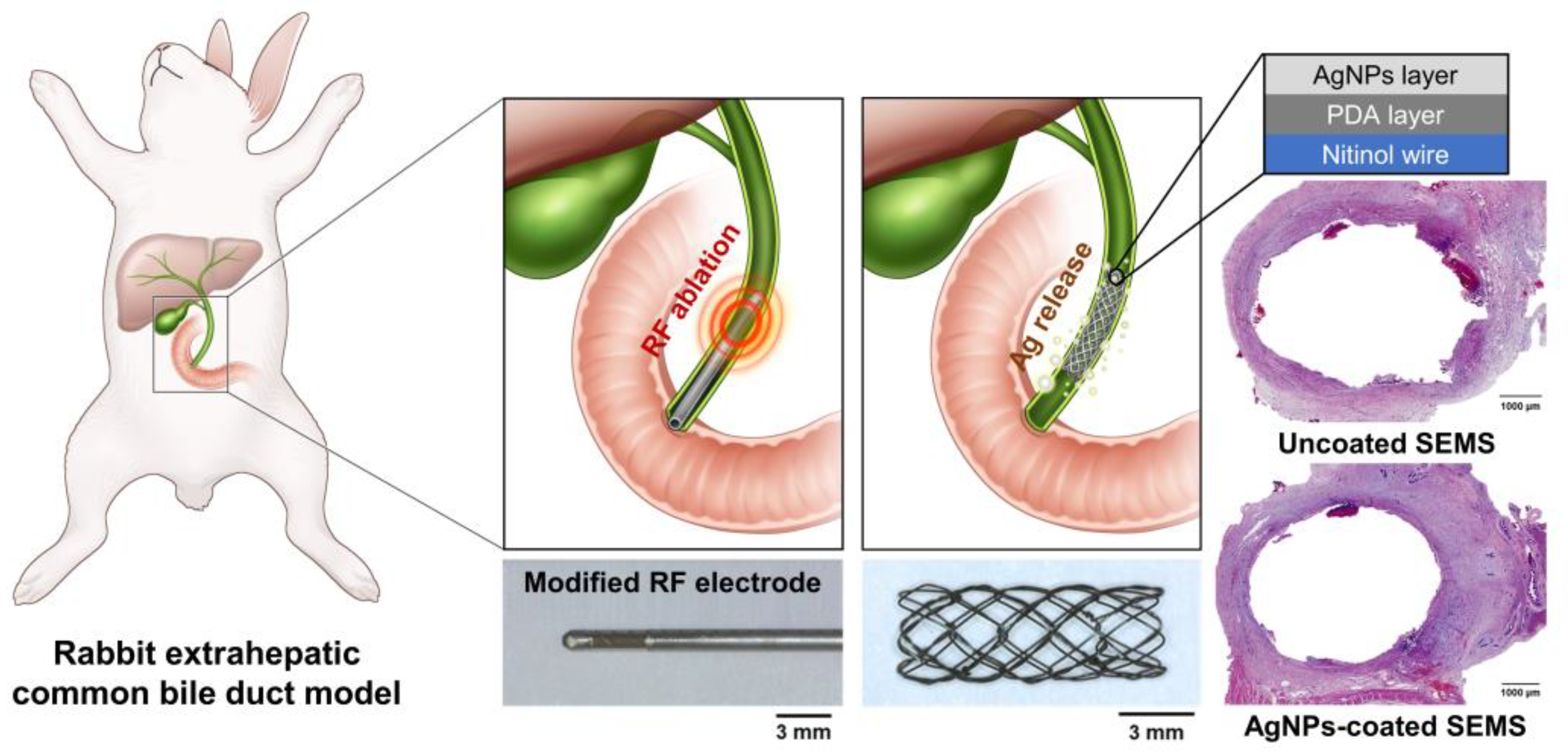
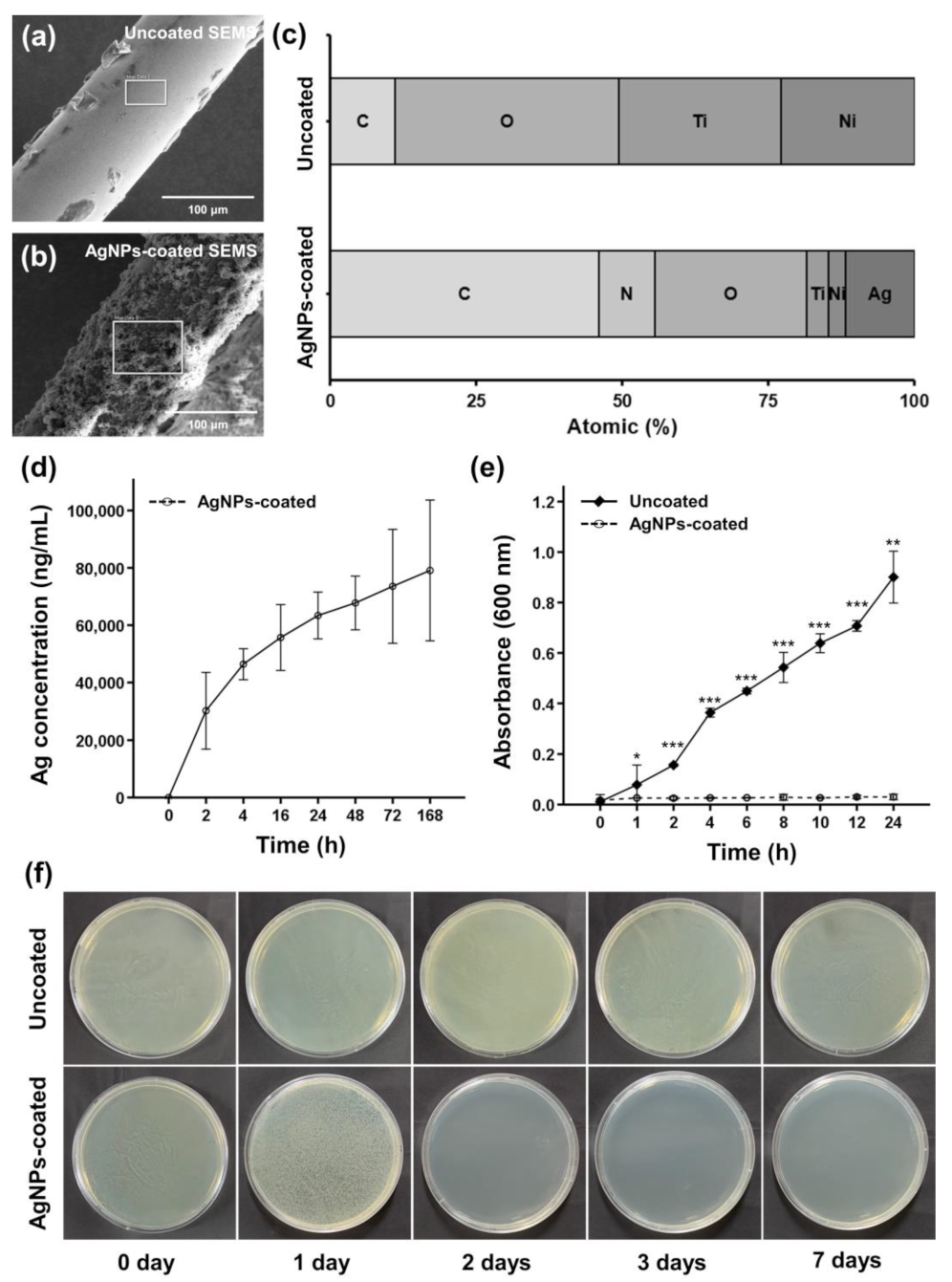
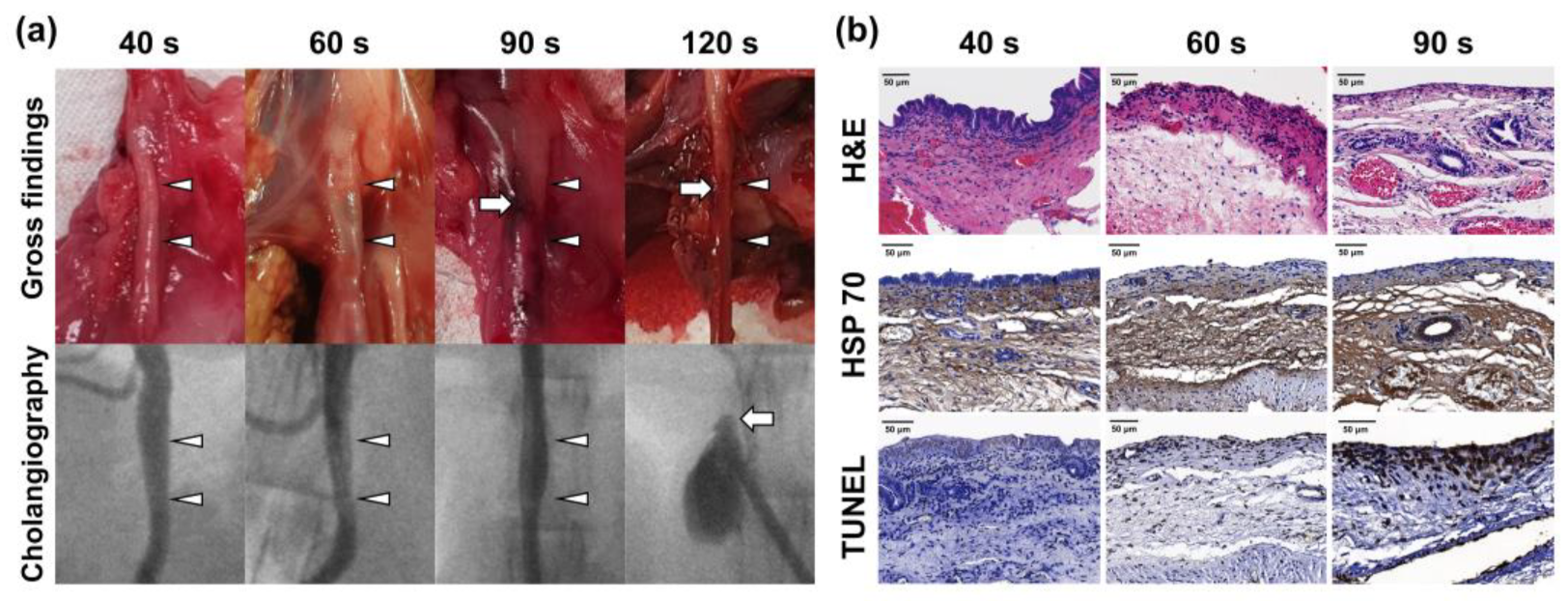

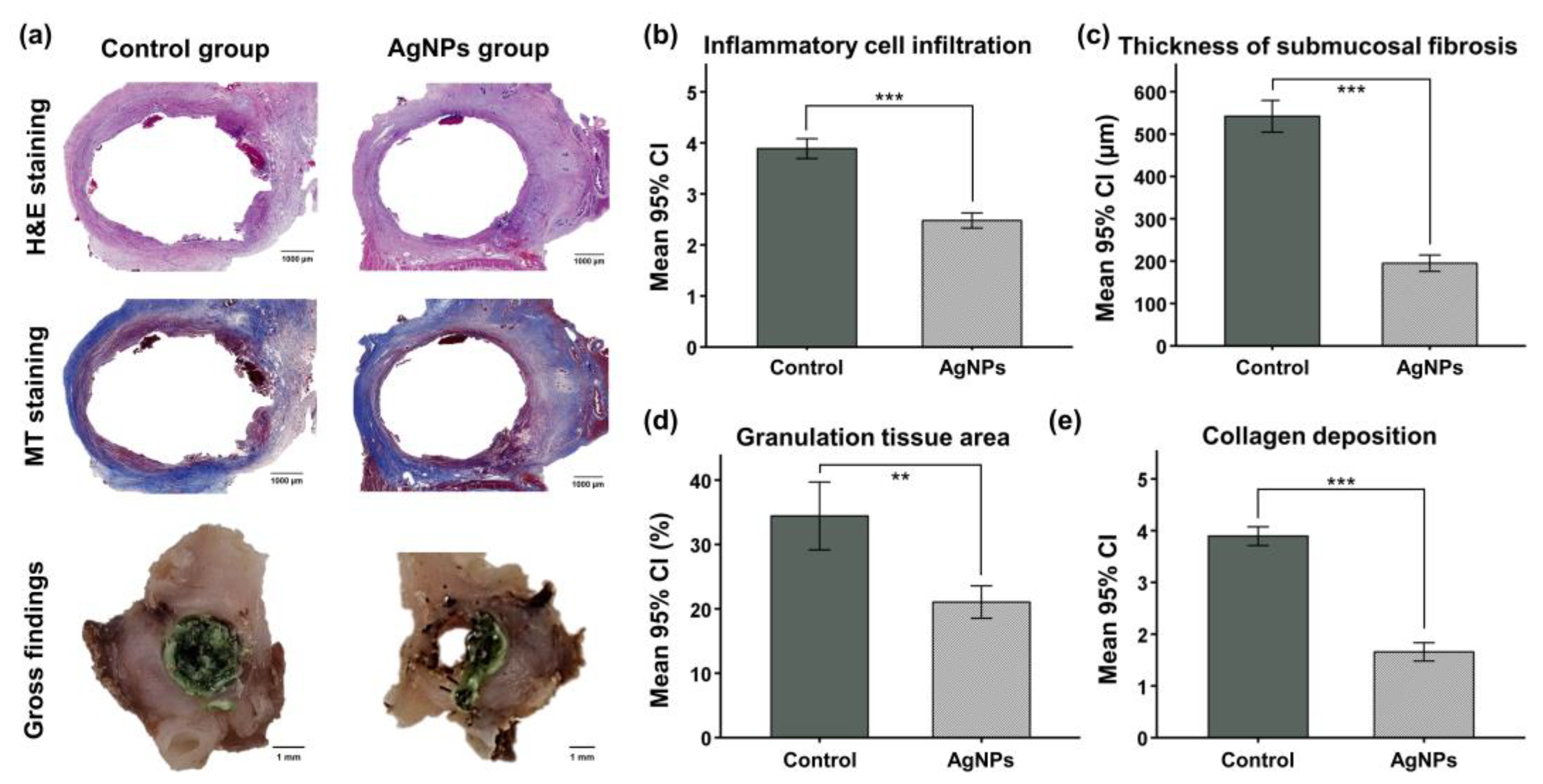
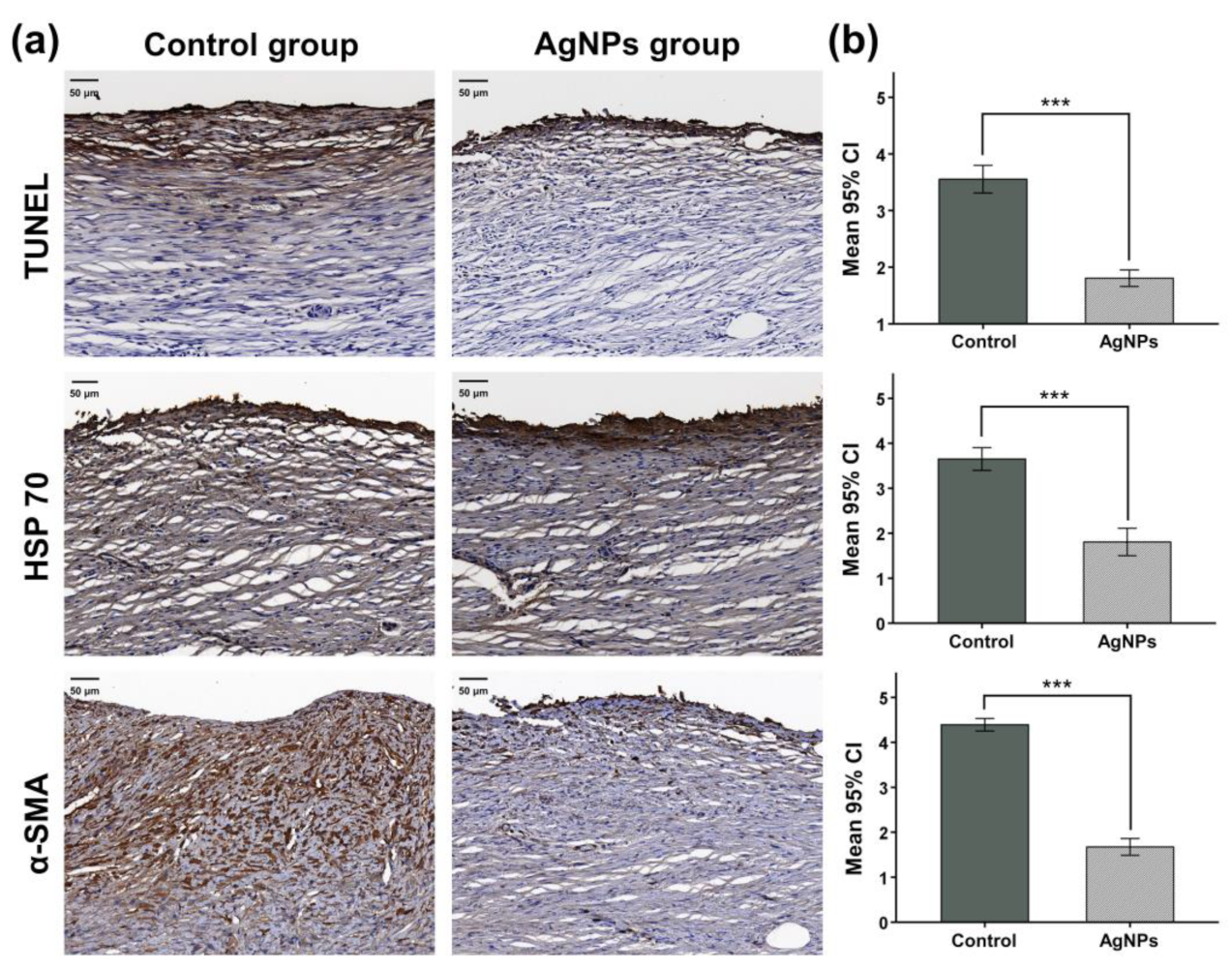
Publisher’s Note: MDPI stays neutral with regard to jurisdictional claims in published maps and institutional affiliations. |
© 2022 by the authors. Licensee MDPI, Basel, Switzerland. This article is an open access article distributed under the terms and conditions of the Creative Commons Attribution (CC BY) license (https://creativecommons.org/licenses/by/4.0/).
Share and Cite
Park, Y.; Won, D.-S.; Bae, G.-H.; Ryu, D.S.; Kang, J.M.; Kim, J.W.; Kim, S.H.; Zeng, C.H.; Park, W.; Lee, S.S.; et al. Silver Nanofunctionalized Stent after Radiofrequency Ablation Suppresses Tissue Hyperplasia and Bacterial Growth. Pharmaceutics 2022, 14, 412. https://doi.org/10.3390/pharmaceutics14020412
Park Y, Won D-S, Bae G-H, Ryu DS, Kang JM, Kim JW, Kim SH, Zeng CH, Park W, Lee SS, et al. Silver Nanofunctionalized Stent after Radiofrequency Ablation Suppresses Tissue Hyperplasia and Bacterial Growth. Pharmaceutics. 2022; 14(2):412. https://doi.org/10.3390/pharmaceutics14020412
Chicago/Turabian StylePark, Yubeen, Dong-Sung Won, Ga-Hyun Bae, Dae Sung Ryu, Jeon Min Kang, Ji Won Kim, Song Hee Kim, Chu Hui Zeng, Wooram Park, Sang Soo Lee, and et al. 2022. "Silver Nanofunctionalized Stent after Radiofrequency Ablation Suppresses Tissue Hyperplasia and Bacterial Growth" Pharmaceutics 14, no. 2: 412. https://doi.org/10.3390/pharmaceutics14020412
APA StylePark, Y., Won, D.-S., Bae, G.-H., Ryu, D. S., Kang, J. M., Kim, J. W., Kim, S. H., Zeng, C. H., Park, W., Lee, S. S., & Park, J.-H. (2022). Silver Nanofunctionalized Stent after Radiofrequency Ablation Suppresses Tissue Hyperplasia and Bacterial Growth. Pharmaceutics, 14(2), 412. https://doi.org/10.3390/pharmaceutics14020412







